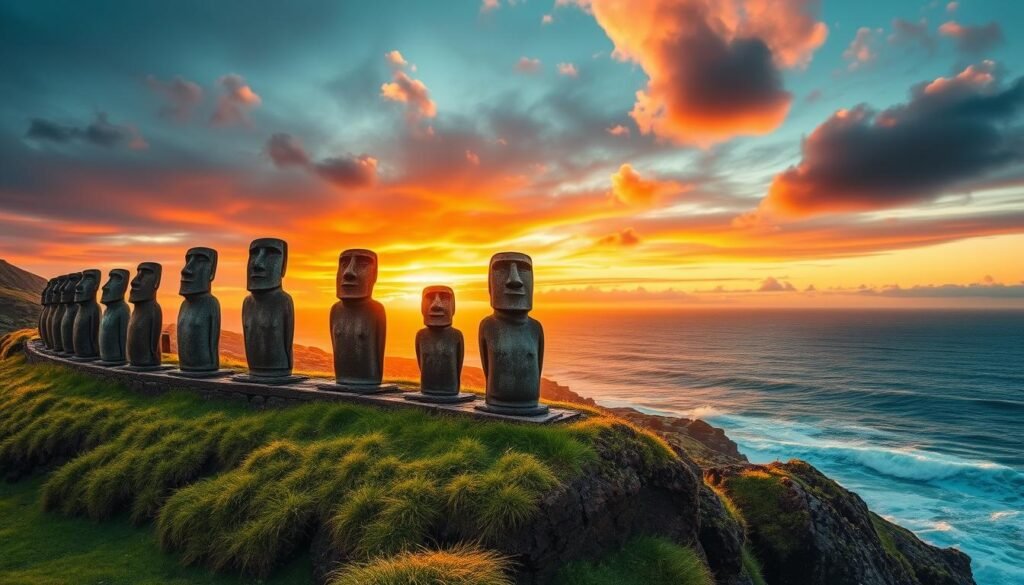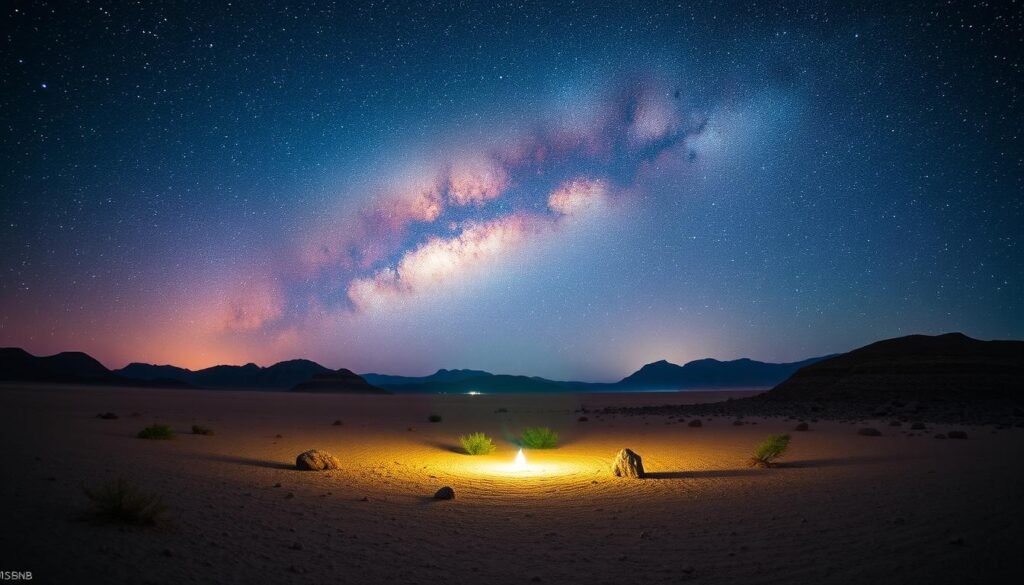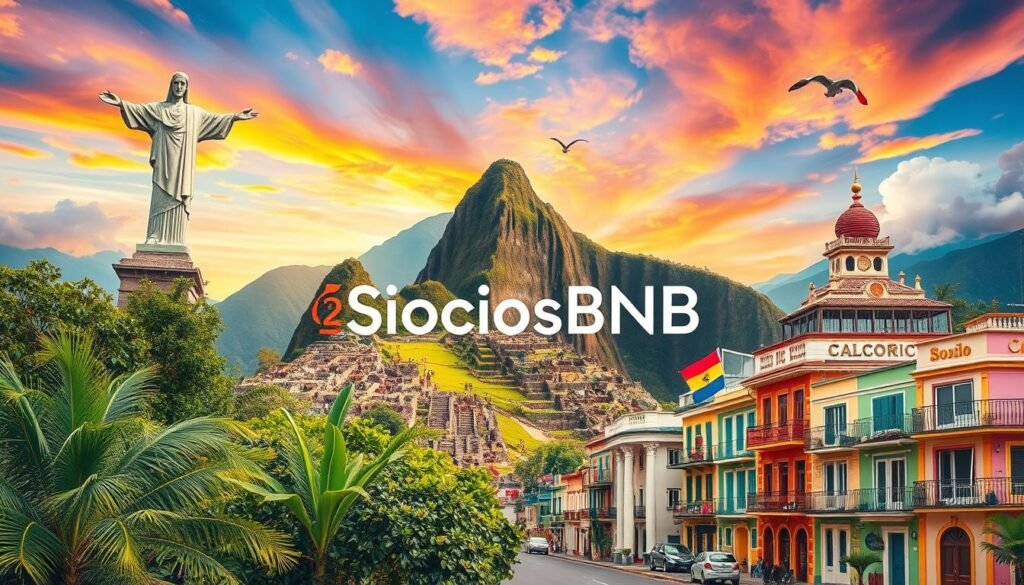I love traveling and exploring the amazing landmarks in Latin America. This region is full of ancient ruins and stunning natural wonders. But what makes these places so famous? And what secrets do they hold?
Join me as we discover some of Latin America’s most iconic sites. We’ll learn the stories and legends that have amazed travelers everywhere.
Key Takeaways
- Latin America is home to a diverse array of famous landmarks, from ancient ruins to stunning natural wonders.
- These landmarks offer a glimpse into the rich history and cultures of the region, captivating travelers from around the world.
- Exploring these iconic destinations can be a transformative experience, revealing the secrets and stories behind their fame.
- Uncovering the hidden gems and lesser-known facts about these landmarks can add depth and meaning to the travel experience.
- Discovering the unique characteristics and significance of each landmark can inspire a deeper appreciation for the region’s heritage and diversity.
So, what is it about these famous landmarks that has made them such enduring symbols of Latin America? Let’s dive in and find out!
Machu Picchu: The Breathtaking Incan Citadel
Machu Picchu, known as the “Lost City of the Incas,” is a famous landmark in Latin America. It sits high in the Andes Mountains of Peru. This place shows the amazing work of the Inca Empire. Visitors can see the detailed stone Inca ruins and terraces, amazed by the Inca’s skill.
Exploring the Ruins and Terraces
Machu Picchu is at 2,430 meters above sea level in a tropical forest. It covers 32,592 hectares of mountains and valleys. The Inca City was built in the fifteenth century but was left when the Inca Empire fell.
About 200 structures make up “La Ciudadela” at Machu Picchu. They show the Incas’ great skill in building and engineering.
Hiking the Inca Trail
The Inca Trail is a famous hike to Machu Picchu. It takes travelers through stunning landscapes and into the site’s history. Fewer people hike the Inca Trail, which takes three to six days. It has many stone steps and high walls.
Machu Picchu is a key tourist spot in Peru. It attracts visitors from everywhere to see its ruins and the Andes’ beauty.
“Machu Picchu stands in the mist, lost to the world for centuries, the kind of place about which one can only dream.”
Christ the Redeemer: Rio's Iconic Statue
The Christ the Redeemer statue stands tall over Rio de Janeiro. It’s a famous landmark in Latin America. This 98-foot tall statue sits on Corcovado Mountain, giving amazing views of Rio’s beaches, mountains, and city.
It took nine years to finish the Christ the Redeemer statue, which was completed in 1931. It’s a symbol of Brazil’s culture and shows the skill of its makers. The statue is made of strong concrete and soapstone, weighing 635 metric tons. Its arms stretch 92 feet wide.
The statue has faced many challenges, like lightning and weather damage. But, a big restoration in 2010 fixed it. Over 60,000 stone pieces were replaced to keep it looking great.
| Fact | Statistic |
|---|---|
| Height of the Statue (excluding pedestal) | 98 feet (30 meters) |
| Arm Span | 92 feet (28 meters) |
| Pedestal Height | 26 feet (8 meters) |
| Height of Mount Corcovado | 2,310 feet (704 meters) |
| Construction Duration | 5 years (1926-1931) |
| Weight of the Statue | 635 metric tons |
The Christ the Redeemer statue is a key symbol of Rio de Janeiro. It’s a top spot for visitors to Brazil. Its design, history, and views make it a wonder that inspires people worldwide.
“The Christ the Redeemer statue is a true marvel of engineering and artistry, standing tall as a symbol of Brazil’s cultural and spiritual heritage.”
Chichen Itza: Mexico's Mayan Marvel
Chichen Itza is a gem on the Yucatan Peninsula of Mexico. It shows the Mayan civilization’s genius and culture. This site, covering nearly two square miles, was once bustling with life. It had up to 50,000 people in the 7th century AD.
The El Castillo Pyramid
The El Castillo pyramid is Chichen Itza’s highlight. It’s almost 100 feet tall. This marvel was built with amazing math and astronomy skills. It shows the Mayans’ advanced knowledge and engineering.
The Great Ball Court
The Great Ball Court is nearby. It’s the biggest in Mesoamerica. This huge field was where the Mayans played a sacred sport. It gives us a peek into their culture and ceremonies.
Visiting Chichen Itza is a thrilling journey. It lets you dive into the Maya’s history and legacy. Every year, over 2.6 million people come to see it. It’s a top archaeological site in Mexico.
| Fact | Statistic |
|---|---|
| Distance from Cancun | Approximately 120 miles |
| City Size in 600 AD | Nearly 2 square miles |
| Estimated Peak Population | Up to 50,000 people |
| Annual Visitors | Over 2.6 million |
“Exploring the ruins of Chichen Itza offers visitors a profound connection to the rich history and legacy of the Maya.”
famous landmarks in Latin America: More Icons to Discover
Latin America is known for its famous landmarks like Machu Picchu, Christ the Redeemer, and Chichen. But it also has many lesser-known spots for a real travel experience. Places like Salvador de Bahia in Brazil and Lençóis Maranhenses National Park show the area’s beauty and diversity.
Exploring places like the Marble Caves in Chile and San Andrés in Colombia adds depth to any trip. The Osa Peninsula in Costa Rica and Montevideo, Uruguay offer unique experiences. They reveal the secrets of Latin America.
“Latin America is made up of 21 countries, stretching from northern Mexico to the southern tip of Argentina. Countries like Bolivia, Brazil, Peru, Ecuador, and Colombia offer access to the Amazon Rainforest, the most bio diverse area in the world.”
| Destination | Unique Feature | Highlight |
|---|---|---|
| Salvador de Bahia, Brazil | Vibrant colonial charm | Colorful historic center |
| Lençóis Maranhenses National Park, Brazil | Otherworldly sand dunes and lagoons | Stunning natural landscapes |
| Marble Caves, Chile | Naturally sculpted caves | Breathtaking turquoise hues |
| San Andrés, Colombia | Island paradise | Pristine beaches and clear waters |
| Osa Peninsula, Costa Rica | Untamed wilderness | Diverse wildlife and ecosystems |
| Montevideo, Uruguay | Elegant urban sophistication | Charming colonial architecture |
Latin America has the Amazon Rainforest and the Andes Mountains. It’s full of natural wonders and cultural treasures. By exploring beyond the famous spots, travelers can find hidden gems. They can experience the true essence of this amazing part of the world.
Salto Ángel: The World's Highest Uninterrupted Waterfall
In the heart of Venezuela’s Canaima National Park, Salto Ángel stands tall. It’s the highest uninterrupted waterfall in the world. This natural wonder drops 3,212 feet from Auyantepui mountain, showcasing Latin America’s raw beauty.
Hiking and Exploring the Falls
Exploring the falls is an adventure. Hikers get to feel the mist and hear the water’s thunder. The Salto Ángel, or Angel Falls, is a sight to behold. It’s 979 meters tall, with a main drop of 807 meters.
Located in Canaima National Park, a UNESCO World Heritage Site, Salto Ángel is a marvel. Jimmie Angel discovered it in 1933. Since then, it has drawn adventurers and nature lovers to Venezuela.
“The falls were officially measured by an expedition led by American journalist Ruth Robertson on May 13, 1949, the first known attempt to climb the face of the cliff was made in 1968, and the first climb to the top of the cliff was completed by a team led by American mountaineer George Bogel in 1971.”
Getting to Salto Ángel is a journey. It involves flights and river trips, best done from June to December. But the view is worth the effort.
Iguazu Falls: Nature's Jaw-Dropping Display
Located on the border of Argentina and Brazil, Iguazu Falls is breathtaking. It has between 150 and 300 waterfalls, depending on the water level. This UNESCO World Heritage site shows the power and beauty of Latin America’s nature.
There are many ways to see Iguazu Falls. You can walk on paths, take boat tours, or fly in a helicopter. Each view is unique and shows the beauty of nature.
The park in Argentina is open from 8 am to 6 pm. Non-residents pay $35,000 pesos to enter. There’s a 50% discount for a second visit if you show your ticket.
The lower circuit trail is 2,500 meters long and takes about an hour to walk. The upper circuit trail is 1,700 meters long and takes about an hour and fifteen minutes. The Devil’s Throat trail is 2,200 meters long and takes about 90 minutes.

For a thrilling experience, try the Gran Aventura boat ride. It costs $70,000 pesos and lasts two hours. You must be at least 12 years old.
The Macuco Trail is 7 kilometers long and takes about 3 hours. It ends with a 23-foot waterfall, offering a unique view of the falls.
Iguazu Falls is a natural wonder that has something for everyone. Whether you’re watching the waterfalls or going on an adventure, it’s unforgettable.
Galapagos Islands: A Living Museum of Evolution
The Galapagos Islands are a natural wonder off Ecuador’s coast. They inspired Charles Darwin’s theories. This remote archipelago is home to unique species found only here.
Incredible Wildlife Encounters
Visitors will see amazing wildlife, like the Galapagos tortoise. They’ll also see marine iguanas and flightless cormorants. These animals have evolved in unique ways, showing how nature works.
Diving and Snorkeling Adventures
The Galapagos Islands are great for diving and snorkeling. Their location creates a rich underwater world. Here, you can see colorful reefs, sea lions, and even Galapagos penguins.
| Key Facts about the Galapagos Islands | Value |
|---|---|
| Total Land Area | 3,093 square miles |
| Total Ocean Area | 23,000 square miles |
| Number of Major Islands | 13 |
| Number of Smaller Islands | 6 |
| Designation | UNESCO World Heritage Site |
| Population (2010) | 25,124 |
The Galapagos Islands are a marvel. They offer a chance to see life’s diversity in a remote Pacific paradise. From wildlife to diving and snorkeling, visiting the Galapagos is unforgettable.
“The Galapagos Islands are a living museum of evolution, a treasure trove of natural wonder that continues to inspire and captivate all who visit.”
Moai Statues: Easter Island's Ancient Marvels
Easter Island, or Rapa Nui, is a remote spot in the Pacific Ocean. It’s famous for its Moai statues. These huge stone heads were carved by the island’s ancient people. They still amaze and inspire visitors today.
The Moai statues are found across the island’s volcanic lands. They show the skill and creativity of the Rapa Nui people. These statues, weighing up to 86 tons, stand up to 10 meters tall.
About 1000 Moai statues are on the island. Most were carved from the Rano Raraku volcano’s tuff rock. They were made between 1400 – 1650 A.D. The people used trade items like sweet potatoes and tools to pay for them.
| Interesting Facts about the Moai Statues | Details |
|---|---|
| Carving and Transportation Techniques |
|
| Facial Features and Adornments |
|
| Theories on the Toppling of the Statues |
|
The Moai statues of Easter Island, or Rapa Nui, show the amazing skill and creativity of the island’s ancient people. Their size, weight, and carving techniques are impressive. These statues continue to fascinate and inspire visitors from all over.

Tikal: Guatemala's Jungle-Clad Mayan City
In the heart of the jungles of Guatemala lies the ancient Mayan city of Tikal. It’s a UNESCO World Heritage site and a top archaeological site in Latin America. Here, visitors can see the towering temple pyramids, plazas, and palaces that were once the center of the Mayan civilization.
Exploring the Towering Temples
Walking through the jungle, travelers dive into the natural and cultural beauty of Tikal. Since 1955, Tikal has been open to the public. It once had about 70,000 people living in 25 square miles at its peak.
Today, visitors can see six standalone temples. The tallest, Temple IV, is about 200 feet tall, similar to Egypt’s smallest pyramids. Only six square miles of the original 25 can be visited on foot now. But the experience is still amazing.
The Plaza of the Seven Temples is a recent discovery. It has seven identical buildings and three ball courts. This shows the advanced engineering and culture of the Mayan people.
| Fact | Value |
|---|---|
| Tikal’s Size | 25 square miles (only 6 square miles can be visited) |
| Tikal’s Population | Approximately 70,000 people at its peak |
| Tallest Temple | Temple IV, standing at around 200 feet |
| Recently Excavated Area | Plaza of the Seven Temples, with 7 identical buildings and 3 ball courts |
Tikal’s history and culture, along with its stunning natural setting, make it a top spot to visit. It’s a key place to see the wonders of Guatemala and the Mayan ruins.
“Tikal was declared a UNESCO site in 1979, further highlighting its global significance as a testament to the ingenuity and legacy of the Mayan civilization.”
Atacama Desert: Nature's Arid Spectacle
The Atacama Desert in Chile is a stunning natural wonder. It draws visitors with its unique landscapes and amazing stargazing. This desert is the driest in the world, with landscapes that look like the moon.
It has towering salt flats, rugged canyons, and colorful lagoons. This makes it a special and beautiful place to explore.
Stargazing in the Clear Skies
The Atacama Desert is famous for its clear night skies. These skies are perfect for stargazing and seeing the stars up close. The desert gets very little rain, and there’s no light pollution.
This makes it a top spot for astronomy fans and nature lovers. It’s a place where you can see the stars in all their glory.
| Best Time to Visit | Average Temperatures |
|---|---|
| Fall and Winter (April to September) | 50°F to 70°F (10°C to 21°C) |
| Spring and Summer (October to March) | 60°F to 80°F (15°C to 27°C) |
Visitors can see the Milky Way and distant galaxies in the Atacama. It’s a truly amazing experience. You can also see flamingos at Chaxas Lagoon and explore the Salar de Atacama.
This makes the Atacama Desert a must-see for those who love nature. It’s a place where you can connect with the beauty of Chile.

“The Atacama Desert is a place of extraordinary natural beauty, where the sky and the earth seem to merge seamlessly, creating an unforgettable canvas for the celestial dance above.”
Conclusion: Uncovering Latin America's Treasures
Reflecting on Latin America’s landmarks and hidden gems, I’m amazed by its power to captivate. The ancient Incan and Mayan sites, towering waterfalls, and island paradises are just the start. This continent is full of cultural and natural wonders that draw travelers from everywhere.
The famous landmarks of Latin America are well-known, but the real magic lies in the lesser-known spots. Exploring these hidden gems has deepened my connection to the region’s heritage and beauty. It’s a chance to experience the legacy of the civilizations that shaped this world.
With each new journey, my excitement grows. I’m eager to find more treasures in Latin America and share the stories of its people and places. Whether it’s ancient ruins, natural wonders, or local communities, Latin America’s allure is endless. It promises discovery, adventure, and cultural immersion at every turn.
FAQ
What are some of the most famous landmarks in Latin America?
Latin America is home to many famous landmarks. Machu Picchu in Peru and Christ the Redeemer in Brazil are well-known. Chichen Itza in Mexico and Salto Ángel in Venezuela are also famous. Iguazu Falls on the Argentina-Brazil border, the Galapagos Islands in Ecuador, and the Moai statues on Easter Island in Chile are also notable. Tikal in Guatemala is famous for its Mayan ruins.
What makes Machu Picchu so special?
Machu Picchu is an Incan citadel in the Andes Mountains of Peru. It shows the Inca Empire’s achievements. The site has stone ruins and terraces, showing the Inca’s engineering and craftsmanship.
The Inca Trail is a popular hike. It lets travelers see the natural landscapes and learn about Machu Picchu’s history.
What is the significance of the Christ the Redeemer statue in Rio de Janeiro?
The Christ the Redeemer statue is a 125-foot tall landmark in Rio de Janeiro, Brazil. It was built in 1931. It symbolizes Brazil’s culture and the skill of its creators.
Visitors can see stunning views of Rio from the statue. They can see beaches, mountains, and the city.
What makes Chichen Itza a remarkable Mayan archaeological site?
Chichen Itza is a Mayan site on Mexico’s Yucatan Peninsula. It shows the Mayans’ ingenuity and sophistication. The El Castillo pyramid is a symbol of their advanced knowledge.
The Great Ball Court is the largest in Mesoamerica. It gives a glimpse into Mayan culture and ceremonies.
What are some of the lesser-known but equally captivating landmarks in Latin America?
Latin America has many hidden gems. Salvador de Bahia in Brazil is known for its colonial charm. Lençóis Maranhenses National Park has unique sand dunes and lagoons.
The Marble Caves in Chile are a natural wonder. San Andrés in Colombia is an island paradise. Costa Rica’s Osa Peninsula is wild and untouched. Montevideo, Uruguay, is elegant and sophisticated.
What makes Salto Ángel, the world’s highest uninterrupted waterfall, so remarkable?
Salto Ángel is a 3,212-foot waterfall in Venezuela’s Canaima National Park. It’s a testament to Latin America’s landscapes. Visitors can hike to see the falls up close.
They can feel the mist and hear the thunder of the water.
What is so unique about the Galapagos Islands?
The Galapagos Islands are a destination for natural wonders. They inspired Charles Darwin’s theories. Visitors can see unique species like Galapagos tortoises and marine iguanas.
They can also dive and snorkel in the islands’ vibrant underwater ecosystems.
What makes the Moai statues on Easter Island so enigmatic?
The Moai statues on Easter Island are mysterious stone heads. They are scattered across the island. They show the Rapa Nui people’s ingenuity and artistry.
These statues stand as a testament to the Rapa Nui’s legacy in this remote environment.
What makes the Mayan city of Tikal in Guatemala so impressive?
Tikal is a UNESCO World Heritage site in Guatemala. It’s one of the best-preserved Mayan sites. Visitors can explore temple pyramids, plazas, and palaces.
It shows the Mayans’ advanced engineering and culture. It’s a window into their sophisticated society.
What makes the Atacama Desert in Chile a unique and captivating destination?
The Atacama Desert is a natural wonder in Chile. It has unique landscapes and great stargazing. It’s the driest desert in the world.
The desert has salt flats, canyons, and lagoons. It offers clear skies for stargazing.



